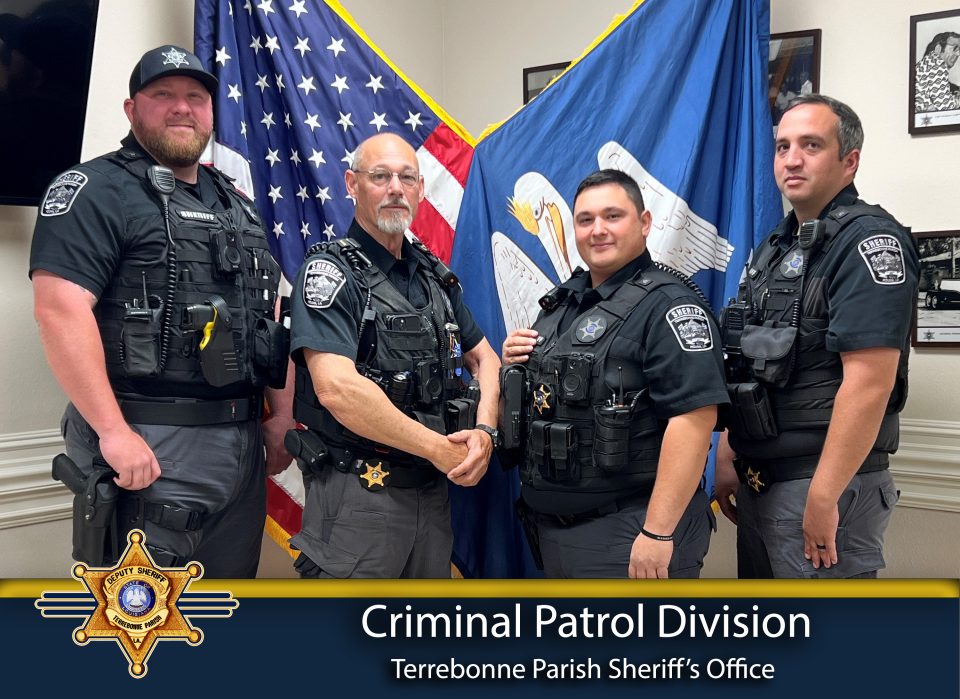Clarence Richardel
April 9, 2007Lafourche deputies foil couple’s illegal romantic fling
April 11, 2007While law enforcement officers around the country have taken heat for use of the Taser, the Lafourche Parish Sheriff’s Office invited members of the media to it’s training facility where officers “took hits” in order to gain their certification to carry the devices.
At the facility, at least 10 officers took hits from the Taser—including Sheriff Craig Webre.
After taking the five-second long hit?
Webre said he tried to count to five when he felt the Taser’s impact. “I got to five in one second,” he joked.
Still, after the five-second experience of incapacitation, all officers got off the mat and walked around the facility talking about the “once in a lifetime” experience.
Webre said the reason for inviting media to the training class was to be “up front” about its use. “We believe that before we deploy the Taser,” he said, “and have to defend the use of the Taser, we want to be up front about it.”
The LPSO uses the Taser X-26, made by TASER International. The device is classified as a non-lethal, intermediate weapon. It puts out 50,000 volts of electrical current that temporarily disrupts the electro-muscular system, allowing officers to respond to resistance or aggression.
Along with that, Webre said that each Taser used by the Lafourche Parish Sheriff’s Office is equipped with a camera. “The fact that we’ll have a camera and video on the Taser … (means) use can be reviewed in the context of the law and our policy.”
The policy that the sheriff talks about is an eight-page Procedural Order on how to use a TASER. Webre said the key aspect of LPSO’s policy is in teaching a Response to Resistance, which was formerly called a Use of Force Continuum. “The main thing is justification,” he explained. “That justification comes from … what we call our Response to Resistance.
“In our policy, we teach a response to resistance,” he added. “Because law enforcement officers do not arbitrarily, and without provocation, initiate force. When force is applied (it’s) simply a response to resistance.”
Webre discussed the Response to Resistance process, saying that the first step is psychological intimidation. “The mere presence of a uniformed police officer,” said Webre, “will cause some people to simply put there hands up and ‘you got me.’”
The next step is a verbalized command. “If you obey the command, the officer has no reason to elevate his response,” explained Webre. “If the officer gives a verbal command, and the person doesn’t respond, then the officer goes to what is known as empty hand techniques. He can put his hands on you. He can attempt to make you submit through empty hand.”
The next step is the use of intermediate weapons—which is what the Taser falls under. “Those intermediate weapons can be a baton, pepper spray and the Taser,” said Webre. “It’s a less lethal, intermediate weapon.”
The next, most extreme, response is deadly force.
Webre said that officers are legally authorized to be one level ahead of the resistance. “So if you’re verbally resisting,” he said, “the officer can use an empty hand.”
But the focus of the day was the Taser. Webre pointed out that TASER International does not require officers carrying the equipment to take a hit—but the LPSO does have that requirement, reasoning that if an officer takes a hit from the Taser, the device will be used more responsibly.
Overall, the LPSO has 140 Tasers.
“What we have been told from agencies such as Jefferson Parish and Thibodaux (Police Dept.), that have Tasers” said Webre, “is once people know that you have a Taser, often times you don’t have to deploy. You simply use the Taser as a deterrent, and people will comply.”










